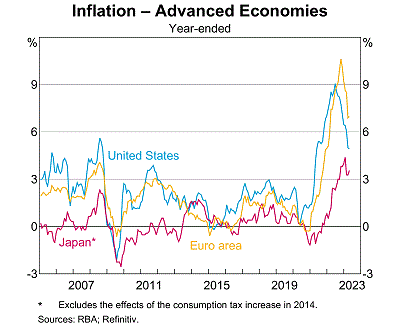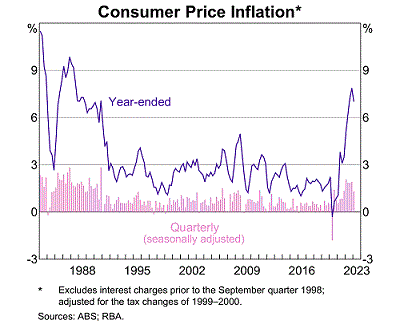The traditional 60/40 equity/bond portfolio has performed poorly during the recent period of high and persistent inflation. With some indication that peak inflation has passed, now seems a good time to do a stock-take on the year so far and what it might imply for portfolios going forward.
It seems to me that the easiest way to parse where markets sit is by way of analogies to three famous children’s stories: The Boy Who Cried Wolf, Goldilocks, and The Pied Piper of Hamelin.
The ‘Goldilocks’ tale’s application to financial markets is well-known; laboured even. The others, however, are less well-known but now perhaps highly apposite.
Despite a stubborn failure for the data to conform, the bond markets have had a tendency since the commencement of the Federal Reserve (Fed) tightening cycle to ‘cry wolf’ regarding recession. The flipside has been a tendency to over-estimate the rapidity with which inflation might decline and the extent of Fed tightening.
That reflected the ongoing effects from what was (with the benefit of hindsight) an excessive fiscal and monetary response during the pandemic and its aftermath. It also may reflect a lack of appreciation that the current monetary policy tightening cycle was from a base of a historically high level of global monetary accommodation. It was also borne of a complacency about the type of inflation inertia that level of monetary accommodation wrought, along with supply shocks encouraged by the pandemic and war and exacerbated by deglobalisation and reregulation.
However, it pays to remember that the famous parable of The Boy Who Cried Wolf concludes with the wolf finally showing up, but only after the townsfolk have been lulled by fatigue into a complacency borne of the unnecessary panic induced after the boy’s false alarms.
Are financial markets too complacent?
Is there a parallel with the market’s current circumstance? Financial markets, perhaps fatigued by unfulfilled prognostications of recession, have grown a little complacent?
If so, the portfolio implications (at least tactically) are clear: a focus on defensive portfolio attributes are primary.
Does that include traditional nominal government bonds as a core component of the ‘40’ in 60/40?
My own view is that it should, at least in the US. Inflation in the US has meaningfully turned: the 3-month annualised core consumer price index (CPI) was 5.0% in May, down from a peak of 7.1% in June 2022, while 3-month annualised Cleveland Fed trimmed-mean measure fell to 3.2% in May, down from a peak of 7.8% in July 2022, and the lowest level since March 2021.
However, inflation does look ‘sticky’ and might remain so.
There are also global structural currents that make elevated developed-country inflation rates more ‘sticky’. The globalisation of labour supply (after the fall of the Berlin Wall and the ‘export’ of labour from large emerging market economies such as China and India) is abating; globalisation of goods markets is in retreat as governments everywhere introduce protectionist measures under the guise of ‘industrial policy’ and ‘national champions’; domestic regulation of markets is increasing in scope (leading to upward price pressures); and baby boomer workforce participation is declining (limiting labour supply and lifting wages).
While US 10-year and 2-year bonds at yields around 3.80% and 4.70% respectively imply that nominal bonds can regain some of their defensive characteristics, other defensive instruments such as inflation-linked bonds, low risk market-neutral (or ‘unconstrained’ / ‘absolute return’) bond funds or even gold and other commodities (as an inflation hedge) or defensive equity portfolios are useful ways to enhance the defensive characteristics of a portfolio.
For domestic investors there is a further rider. Inflation appears to have passed a meaningful turning point in the US. However, locally, questions remain.
The recent decision by the Fair Work Commission (FWC) will increase price pressures and increase pressure on the Reserve Bank of Australia (RBA) for further policy rate increases. Such wage increases are digestible in times of reasonable productivity growth, but the recent national accounts showed productivity growth at an abject -4.5% over the past year, and unit labour cost growth (the most relevant labour cost gauge for inflation) is at a whopping 7.9% – and this was before the FWC decision.
So, while inflation in the US may have passed a meaningful turning point, Australia faces a more serious challenge, and the RBA may have a fair bit more ‘wood to chop’ and local bond yields some upside. Locally, on a ‘duration neutral’ basis, defensive portfolios are best skewed toward inflation-linked bonds and other defensive assets rather than nominal bonds.


Arguably a combination of an RBA that was late out of the gates on inflation and who then prevaricated on its commitment to inflation containment, combined with wage-setting arrangements inimical to inflation containment, has increased the chances of a deeper dislocation in employment and activity in Australia than elsewhere as the RBA struggles to get ahead of the inflation curve.
In this sense Australia has yet to pay the (inflation) piper.
Where does this leave portfolios?
In the US, the traditional 60/40 equity/bond portfolio might make something of a comeback, although with the inclusion of return sources uncorrelated with equities or bonds. Perhaps something like a 50/30/20 portfolio with the ‘20’ being assets uncorrelated with equity or bond returns (e.g., long/short or ‘market neutral’ bond and equity portfolios or macro hedge funds) offers better diversification. And even with nominal bonds as the core defensive asset, other defensive assets such as inflation-linked bonds might appeal.
In this way, should the recession wolf show up, villagers (investors) can protect the livestock (portfolios) with nominal bonds and other defensive (mostly inflation-hedge) assets.
For Australian investors, given the tasks facing the RBA and the potentially ‘stickier’ inflation outlook, the calculus is not so clear. The appropriate portfolio mix might look more like 45/25/30, with the ‘30’ being assets uncorrelated with equity or bond returns. Moreover, given the idiosyncratic (upside) inflation risks in Australia, it may pay to have a reasonable proportion of the ‘45/25’ component in foreign (mostly US) equity and bonds.
Of course, this survey would not be complete without a contemplation of the ‘Goldilocks’ narrative. Can the Fed successfully engineer a relatively benign disinflation (so-called ‘immaculate disinflation’) without an excessive dislocation in activity and employment (it looks less likely for the RBA)?
That rarely happens, but…
Stephen Miller is an Investment Strategist with GSFM, a sponsor of Firstlinks. He has previously worked in The Treasury and in the office of the then Treasurer, Paul Keating, from 1983-88. The views expressed are his own and do not consider the circumstances of any investor.
For more papers and articles from GSFM and partners, click here.